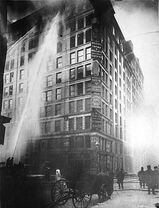An old door knob from the Triangle Shirtwaist Factory fire.
Background[]
As the fire within the factory spread, the workers became trapped inside. The door knob absorbed their pain and suffering as the women tried to get out alive - as such, holding the doorknob in one's hand will inflict the same agonizing burns on the victim as the workers received. Agent Steve Jinks learned that it is capable of causing injury even through neutralizer gloves when it burnt through his whilst being snagged. This effect becomes worse with prolonged exposure, eventually causing spontaneous combustion and death. It is currently in the Warehouse.
Usage[]
It was discovered on a farm in Wisconsin, owned by a woman whose great uncle who had an OCD that made him want to collect door knobs. After it was collected by Agents Jinks and Donovan, it was stolen by Sally Stukowski, who would later use it to torture and kill Theadora Stanton. The doorknob was found in Stukowski's purse when Warehouse Agents apprehended her, and was quickly bagged.
In "Endless Terror", Paracelsus traveled back in time and killed the Regents of Warehouse 9 thereby altering history. In this alternate time line, Paracelsus was sole authority over the Warehouse and had been Caretaker for Warehouses 9 through 13. In this alternate Warehouse, Paracelsus experimented with artifacts by testing them on people. Artie saw two scientist forcing a man to hold the Doorknob in one hand and the Phoenix in the other, the Doorknob creates fire and the Phoenix repels it so Paracelsus must've been curious to know what these two artifacts would do when combined.
Real World Connection[]
The Triangle Shirtwaist Factory fire in New York City was the worst industrial disaster in the history of the city of New York and resulted in the fourth highest loss

of life from an industrial accident in U.S. history. It was also the second deadliest disaster in New York City until September 11. In 1911, a fire broke out in the factory, the doors were locked from the outside-a common practice at the time to prevent pilferage and unauthorized breaks- trapping the workers inside. Most of the workers couldn't get to the fire escapes, and those that could discovered that fire escapes were poorly constructed, and ended three floors above street level. The fire fighters' ladders weren't tall enough to reach the upper floors of the building, as well. The total number of people that died were 146, who died from the fire itself, smoke inhalation, or falling to their deaths (Most women and/or men jumped out of the windows.). The fire led to legislation requiring improved factory safety standards and today the original building is a historic landmark.



